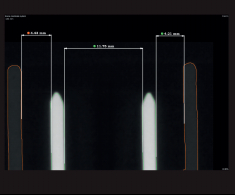Volume Graphics' Version 3.3 Enables High-Quality Volume Meshing
Volume Graphics’ version 3.3 of VGStudio Max, VGStudio, VGMetrology and VGinLine for industrial computed tomography (CT) is said to cover all requirements related to metrology, defect detection and assessment, material properties, and simulation.
Share
Read Next

A new mode of multi-material surface determination facilitates segmentation of multi-material objects
Volume Graphics’ version 3.3 of VGStudio Max, VGStudio, VGMetrology and VGinLine software for industrial computed tomography (CT) is said to cover all requirements related to metrology, defect detection and assessment, material properties, and simulation.
With the updated version, users can determine the surfaces of multi-material components; export measurement and analysis results to store them centrally in quality-management software; automate inspection processes more flexibly based on text recognition; and translate real CT data into volume meshes for simulation.
The update includes a new mode of local-adaptive-surface determination which enables the simultaneous determination of multiple material surfaces within a volume in one go. According to the company, this simplifies the geometric dimensioning and tolerancing of multi-material objects.

This screen capture represents one of the many wall-thickness analyses whose results can be exported in common Q-DAS data exchange format.
There is also native support for data export in Q-DAS data exchange format as well as export of detailed, CT-based measurement and analysis results (coordinate measurement, nominal/actual comparison, wall thickness analysis, porosity/inclusion analysis, and fiber composite material analysis).
“Using the new data export, metrology data derived with the tremendous measurement capabilities of our software can be seamlessly shared with QA systems, where the values can then be combined and checked over time” says Christof Reinhart, CEO and co-founder of Volume Graphics GmbH. “More than ever before, this new feature enables customers to better integrate leading-edge CT technology into their existing software landscape. The new export feature is based on the native support of the widely used Q-DAS format, which makes using results in third-party statistical or analysis software especially easy.”
The optical character recognition (OCR)-based automation provides users the ability to read out and store recognized text in their meta information. In automated inspection workflows, cavity markers in CT scans of injection molded or cast components can be recognized and the right reference object or the appropriate analysis in VGinLine jobs can then be selected depending on the respective cavity.

Version 3.3 covers the complete workflow from CT scan to volume mesh.
With the new Volume Meshing Module for simulations, users can create accurate and high-quality tetrahedral volume meshes from CT scans for use in mechanical, fluid, thermal, electrical and other FEM simulations in third party software. Each cell of the generated volume mesh can be loaded with additional information required for simulation, such as fiber orientations, fiber volume fractions, porosity volume fractions or gray values.
Volume Graphics has also added a new Technical Consulting unit that provides professional consulting and evaluation services.
Related Content
-
Solving 3D Printing’s Hidden Problem: Vibration
Ulendo’s vibration compensation software can double the speed of FFF 3D printers while maintaining part quality, all without changing the machine’s hardware.
-
Aircraft Engine MRO: How Additive Manufacturing Plus Robotic Finishing Will Expand Capacity for Blade Repair
AM offers the chance to bring fast, automated processing to individualized, part-by-part restoration of turbomachinery. A cell developed by Acme Manufacturing and Optomec is able to automatically repair 85,000 unique aircraft engine blades per year.
-
Copper, New Metal Printing Processes, Upgrades Based on Software and More from Formnext 2023: AM Radio #46
Formnext 2023 showed that additive manufacturing may be maturing, but it is certainly not stagnant. In this episode, we dive into observations around technology enhancements, new processes and materials, robots, sustainability and more trends from the show.














